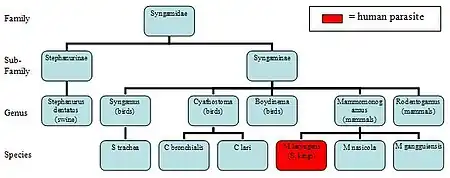| Syngamidae | |
|---|---|
| Scientific classification | |
| Kingdom: | |
| Phylum: | |
| Class: | |
| Order: | |
| Superfamily: | Metastrongyloidea |
| Family: | Syngamidae Leiper, 1912 |
The Syngamidae are a family of nematodes which commonly parasitize mammals, birds, and rarely humans.[1] They are classified in the Strongyloidae superfamily and Strongylata order.[2]
Notable species within the family Syngamidae include Syngamus trachea, commonly known as the gapeworm, which infests birds, and Mammomonogamus laryngeus, which is a parasite of ungulates, cats, and orangutans, and which can accidentally infect humans.[2]
Parasitic infection occurs when the host ingests the parasite via contaminated food, water, or intermediate hosts like earthworms, snails, and arthropods. Worms usually migrate and inhabit the respiratory tract of hosts, where the male and female worms join in permanent copulation.[3]
Syngamidae nematodes are globally distributed and are important in veterinary parasitology.[4]

References
- ↑ Anderson RC, Chabaud AG, Willmott S. CIH keys to the nematode parasites of vertebrates, no 7. Keys to genera of superfamily Strongyloidea. Commonwealth Agricultural Bureaux, England, 1980.
- 1 2 Eamsobhana P, Mongkolporn T, Punthuprapasa P, Yoolek A (2006). "Mammomonogamus roundworm (Nematoda: Syngamidae) recovered from the duodenum of a Thai patient: a first and unusual case originating in Thailand". Trans R Soc Trop Med Hyg 100: 387–91.
- ↑ Severo LC, Conci LMA, Camargo JJP, Andre-Alves MR, Palombini BC. Syngamosis: two new Brazilian cases and evidence of possible pulmonary cycle. Trans R Soc Trop Med Hyg. 1988;82: 467–8.
- ↑ Gutierrez, Yezid. Diagnostic Pathology of Parasitic Infections with Clinical Correlations. 2nd ed. New York: Oxford University Press, 2000.